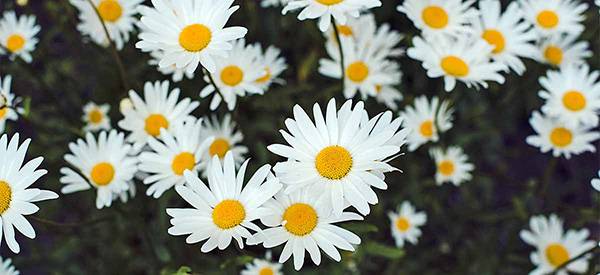
Chamomile
Chamomile is a hardy annual and a member of the large daisy (Asteraceae) family. There are several types of Chamomile, but two are more common and well-known globally: German and Roman Chamomile.
However, it is German Chamomile (Matricaria recuita) this article focuses on as it is considered the more potent and is therefore used in medicinal preparations and remedies.
The History of Chamomile
The first records of Chamomile as herbal medicine go back over 2,000 years to when the Ancient Greeks used it. It was used as a panacea or cure-all because it was believed to be effective against a wide range of conditions and symptoms. It appears that in Ancient Rome it was especially valued as a treatment of female reproductive disorders.
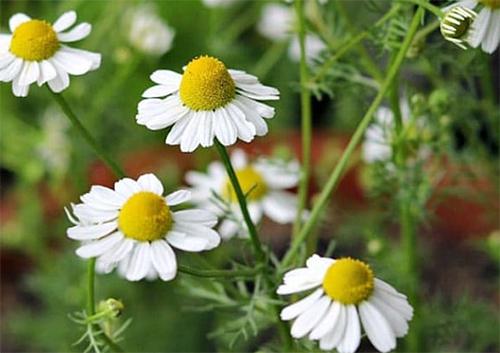
This remarkable plant was used for, amongst other things, headaches, anxiety, muscle spasms, digestive upsets, gout and rheumatism, fever, insomnia, and gastric ulcers.
It was also used topically for bruises, minor wounds, acne, and irritated skin.
Today, Chamomile is considered the herbal version of Valium as it is believed to have calming effects, lower anxiety, and ease insomnia. In addition, it is used to soothe the stomach.
Where This Plant Is Found
Chamomile is native to parts of Europe and to western Asia. It has now been naturalized and is found throughout Europe including the UK, the US, Canada, regions in Africa, and in Australia.
Related: The Complete Map of Edible Plants: Find Out What You Have in Your Area! (Video)
How To Identify Chamomile
Although you can use either for herbal medicine purposes, German is preferable to Roman Chamomile (Chamaemelum nobile). Interestingly, Roman Chamomile is a true Chamomile and German is not. The differences are discussed in more detail in a later section.
Looking specifically at German Chamomile, the identifying features are:
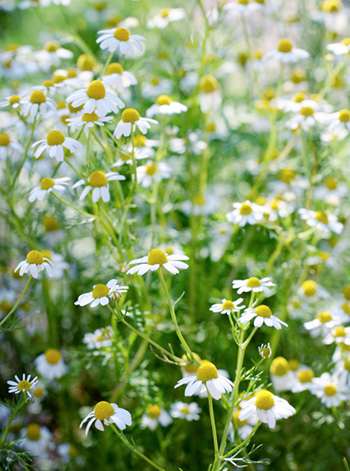
- Stems: The stems are upright, and these plants reach a height of 1 – 2 feet or 30 – 60 centimeters
- Leaf: the leaves are finely dissected/divided into multiple, narrow segments which gives them a feathery look
- Flower: the petals are white, and the center is yellow, hollow, and domed. Each flower is carried on a single stem. The petals point downwards as the bloom fades.
German Chamomile is self-seeding, grows vigorously, and flowers prolifically throughout the summer months.
How To Grow Chamomile
You can allow plants to self-seed, plant seeds, or buy young plants from a nursery or garden center. Whether you are using seeds or plugs, planting should be done in spring. Growing Chamomile is not difficult as they: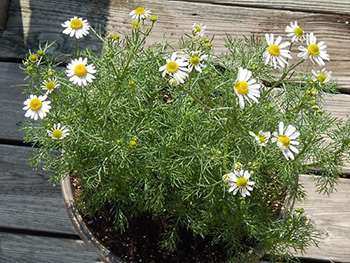
- Will grow in sun or part shade
- Like dry soil and are drought tolerant although not for an extended period
- Need little attention
- Don’t like fertilizer; it results in reduced flavor/potency and fewer blooms
- Are pest-resistant to a large degree
The seeds can simply be scattered over bare soil and germinate within two weeks of sowing. If allowed to self-seed, a few Chamomile plants will become dozens very quickly! A plant will usually bloom 6 – 10 weeks after the seed germinates and will continue to produce flowers until the first frosts arrive.
In terms of maintenance, if you plant Chamomile in containers rather than a garden they will need to be watered more often as the soil in pots dries out far more rapidly. Also, if plants are starting to look spindly or leggy, trim back some of the growth to encourage denser, more compact growth.
Get Your Own Chamomile Seeds, Last 30 Packs Left
How to Harvest And Process This Plant
Chamomile blooms for many months and produces large numbers of flowers. This allows you to harvest flowers every 10 – 14 days. As a bonus, plants that have their flowers picked will flower better and for longer.
Fully open, mature flowers that haven’t started to droop contain the highest levels of beneficial properties. The best time of day to pick the flowers is in the morning, but don’t harvest them if they are still wet with dew or from rain; leave them to dry naturally.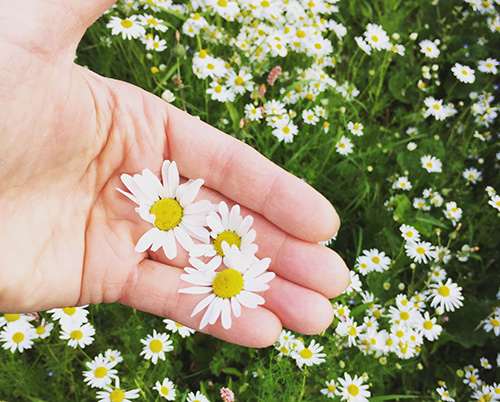
Only remove the flower head when you harvest Chamomile. Be careful when you do so as not to pull off stems or damage the plant. It’s best to nip them off with your fingernails or use scissors to cut through the stem immediately below the flower head. If you want to allow your Chamomile plant(s) to self-seed, or you want to collect seed to plant the following season, remember to allow leave some flowers to go to seed.
After picking the flowers, you can either wash them or gently shake them to remove any dirt or insects that may be present. If you wash them, you need to gently pat the blooms dry afterward. You have two options when it comes to drying:
1. You can allow the flowers to air dry by spreading them out in a single layer on a clean cloth or brown paper. Place them in a warm, dark place to dry for a week or two.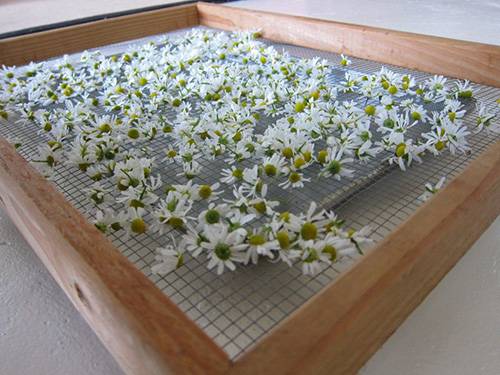
2. Alternatively, you can use a dehydrator or your oven. Be careful that you gently dry the flowers and don’t burn them; use the lowest possible setting and check the blooms frequently.
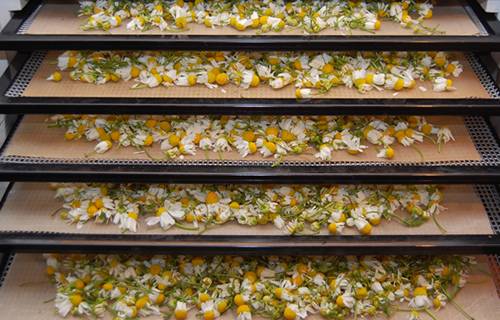
Correctly dried flowers can be stored in an air-tight jar for a year. However, if flowers are not properly dry, mold will develop, and you will have to throw the flowers away. Some people prefer to pick just enough flowers for a cup or pot of tea made with fresh rather than dried flowers.
What Chamomile Is Good For And The Natural Remedies Made From It
As indicated earlier, one of the reasons for Chamomile’s centuries-long popularity is down to how many health problems it can be used for. While there is not much (or any) clinical evidence to support some of the claims, there is a great deal of anecdotal evidence. This body of information indicates that Chamomile, in various forms, can be used to:
- Ease mild or moderate anxiety and depression

- Ease insomnia / promote sleep
- Treat digestive system issues including spasms, mild diarrhea, and ulcers
- Promote the healing of minor wounds
- Treat mild skin conditions such as rashes, sunburn, acne, and eczema
- Slightly lower blood sugar levels
- Reduce gingivitis and oral plaque.
While some of the above are disputed in some quarters, it is amazing to realize that this humble plant’s extract contains more than 120 active ingredients that offer antibacterial, anti-inflammatory, antispasmodic, and antioxidant properties.
Chamomile Seeds: Last Minute Deal
What Parts of The Plant Are Used in Remedies?
All parts of the Chamomile plant contain the valued essential oil. However, it is at its greatest concentrations in the flowers. The blooms are used to produce a range of remedies including essential oils and tea.
A DIY Chamomile Recipe
Even if the caffeine in coffee (or even tea) doesn’t keep you awake if you drink it late in the day, many people want to remove caffeine from their diets for health reasons. A number of these individuals have discovered – and enjoy – Chamomile tea.
However, there is another option for those who want a warm, frothy, caffeine-free drink: Chamomile Tea Latte. Here’s how to make one:
Ingredients
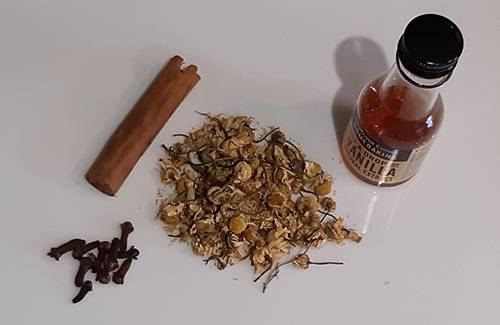
- 2 tablespoons of loose Chamomile flowers/tea
- 3 – 5 cloves
- 2 teaspoons of vanilla extract
- 2 cups of milk of your choice
- 1 cinnamon stick
- Ground cinnamon for garnish.
Method
- Put the milk, Chamomile, cloves, and cinnamon stick into a small saucepan

- Place the saucepan over a medium-low heat
- As soon as small bubbles begin to form along the sides, turn down the heat so the liquid is just simmering. Don’t let the milk boil!

- After 2 – 3 minutes turn the heat off and leave the mixture to steep for 5 – 10 minutes
- Strain the liquid using a fine sieve into a French press

- Add the vanilla extract (and honey if you enjoy the extra sweetness)
- Move the plunger in and out 6 – 8 times. Be careful as the milk will almost double in volume

- Pour the frothy liquid into a cup or mug and garnish with a sprinkle of ground cinnamon if you want to.
Of course, you can experiment with flavoring until you find the combination that’s right for your palette.
Dosage
Given the lack of broad clinical research into Chamomile, it is not surprising that there are no set doses. In addition, it depends on the type of preparation that you are using and what problem you are treating.
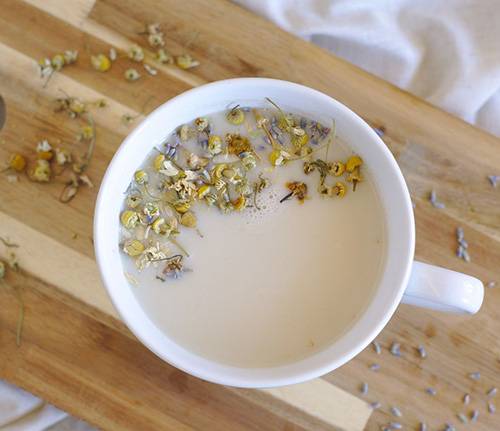
However, generally, you should be guided by the directions on the packaging of bought remedies and/or by your healthcare practitioner.
You can also use Chamomile topically for swollen joints or irritated eyes:
What Plants Resemble Chamomile?
There are several plants that are confused with German Chamomile. Looking at the similarities and differences can help:
| Feature | German ChamomileMatricaria chamomilla / Chamomillarecutita | Roman ChamomileChamaemelum nobile / Anthemis nobilis | FleabaneErigeron aureus | Oxeye DaisyLeucanthemum vulgare |
|---|---|---|---|---|
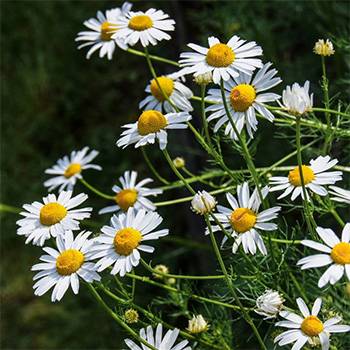 |
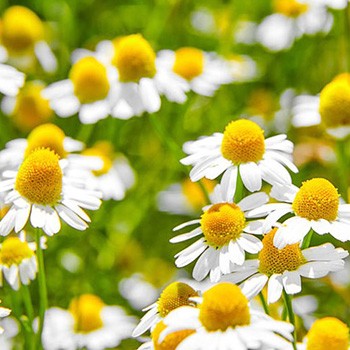 |
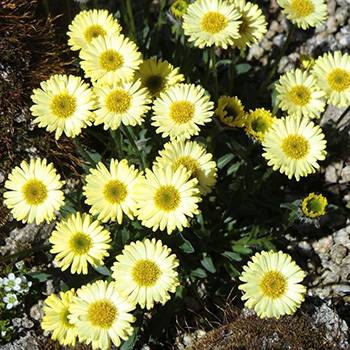 |
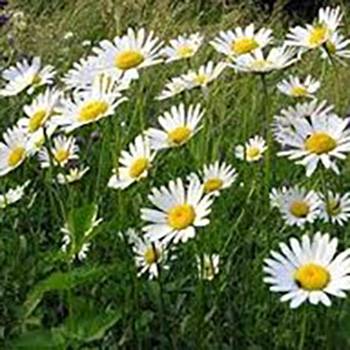 | |
| Growth | Upright stems | Creeping groundcover | Basal leaf clump and erect stem | Upright stems |
| Size | 1 – 2 feet / 30 – 60 cm in height | Low, compact groundcover | 4 - 8” / 10 – 20 cm in height | 1 – 2 feet / 30 – 60 cm in height |
| Leaves | Delicate, feathery; long, narrow lobes | Feathery; long, narrow lobes | Whole; lance-shaped / oblong; toothed; hairy | Whole; toothed / serrated edge |
| Flowers | White petals | Small flower, white petals | Flat head; long, thin petals; yellow | Large, long petals; white |
| Center of flower | Domed, hollow, yellow | Conical, yellow | Slight domed, sunken center, yellow | Disc-shaped, flat, sunken center, yellow |
If you are unsure of plant identification, it’s best not to harvest it for ingestion or topical application!
Add Chamomile to Your Backyard, Last 30 Packs Left!
Warning And Cautions
Just because a remedy or preparation is plant-based and therefore natural does not necessarily mean that it is 100% safe. Some individuals need to either avoid Chamomile or exercise caution:
- People who are allergic to members of the daisy family
- Pregnant and breastfeeding women
- Patients on blood-thinning medications
- Women suffering from hormone-sensitive conditions such as uterine fibroids or endometriosis
- Individuals scheduled for surgery should not use Chamomile in the 2 weeks prior.
The bottom line is that everyone, but particularly individuals with a medical condition they receive medication for, should consult their healthcare provider before using Chamomile or any new remedy or preparation.
You may also like:
 The 6 Best Bedtime Teas To Help You Sleep
The 6 Best Bedtime Teas To Help You Sleep
Erratic Blood Sugar? Never Eat This Veggie (Video)
Soak Your Troubles Away with Homemade Tub Tea








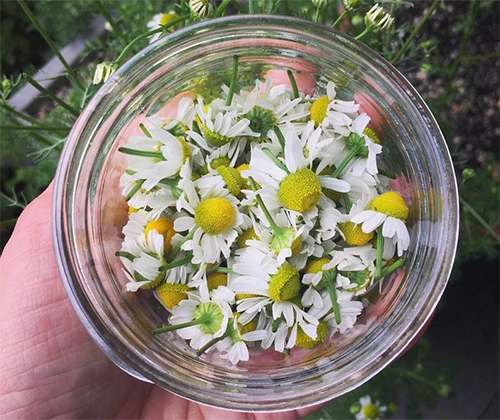

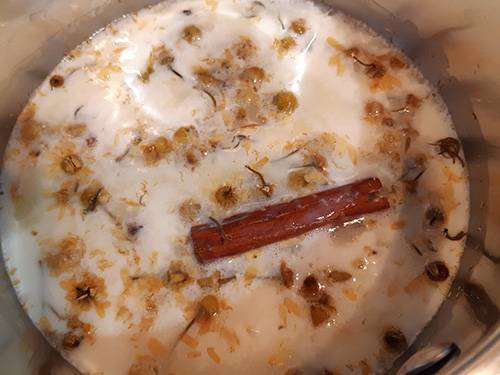

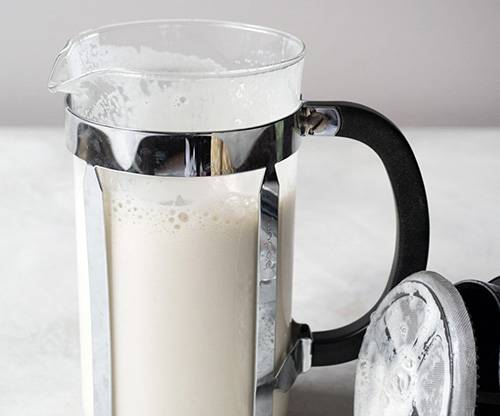
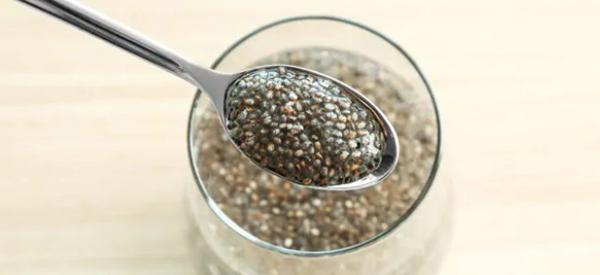
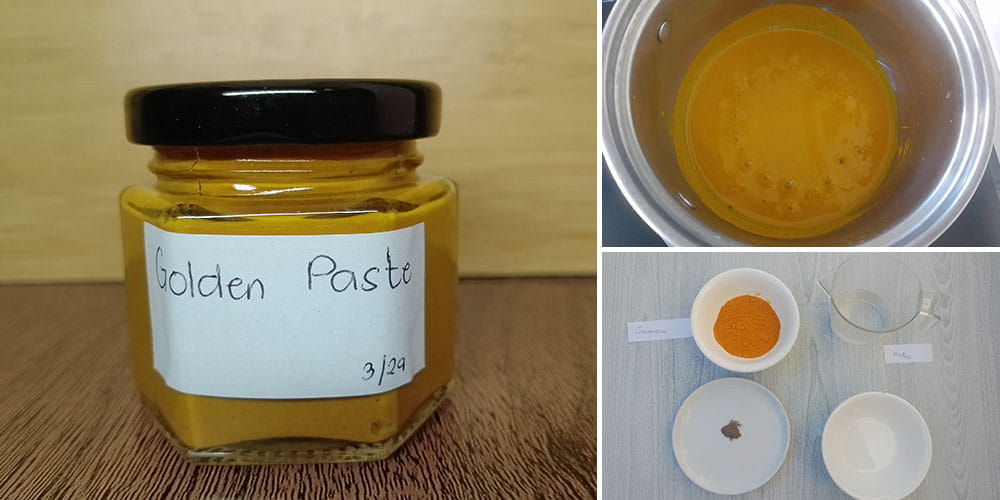
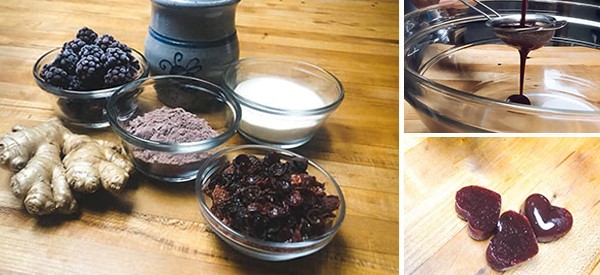
I love this plant. Thank you for sharing.
will pineapple weed work? I don’t have chamomile.
Hi Marian,
Yes, there are also many impressive health benefits of using pineapple weed for people suffering from fever, insomnia, parasitic infections, chronic pain, inflammatory conditions, skin irritation, wounds, indigestion, stress, anxiety, and a weak immune system.
Dry flower heads of pineapple weed are often used to brew an herbal tea, and this remains the most popular use of this herb. You only need 5-6 flower heads and can add honey to sweeten the flavor or dilute the taste of pineapple.
God bless!
When I take Chamomile it makes me nervous the complete opposite of what it’s supposed to do. Why is this?